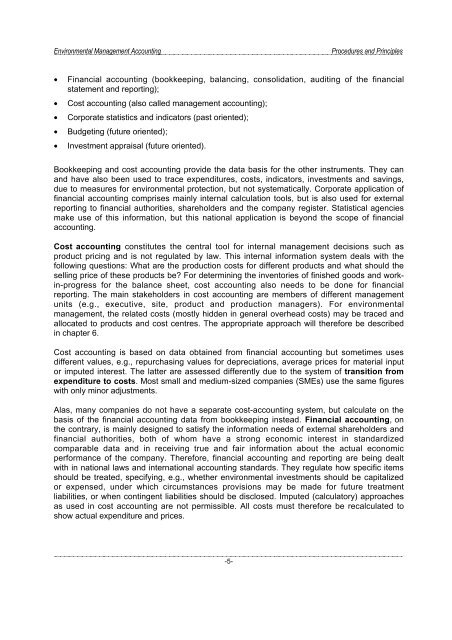Environmental Management Accounting Procedures and Principles
Environmental Management Accounting Procedures and Principles
Environmental Management Accounting Procedures and Principles
Create successful ePaper yourself
Turn your PDF publications into a flip-book with our unique Google optimized e-Paper software.
<strong>Environmental</strong> <strong>Management</strong> <strong>Accounting</strong><br />
<strong>Procedures</strong> <strong>and</strong> <strong>Principles</strong><br />
• Financial accounting (bookkeeping, balancing, consolidation, auditing of the financial<br />
statement <strong>and</strong> reporting);<br />
• Cost accounting (also called management accounting);<br />
• Corporate statistics <strong>and</strong> indicators (past oriented);<br />
• Budgeting (future oriented);<br />
• Investment appraisal (future oriented).<br />
Bookkeeping <strong>and</strong> cost accounting provide the data basis for the other instruments. They can<br />
<strong>and</strong> have also been used to trace expenditures, costs, indicators, investments <strong>and</strong> savings,<br />
due to measures for environmental protection, but not systematically. Corporate application of<br />
financial accounting comprises mainly internal calculation tools, but is also used for external<br />
reporting to financial authorities, shareholders <strong>and</strong> the company register. Statistical agencies<br />
make use of this information, but this national application is beyond the scope of financial<br />
accounting.<br />
Cost accounting constitutes the central tool for internal management decisions such as<br />
product pricing <strong>and</strong> is not regulated by law. This internal information system deals with the<br />
following questions: What are the production costs for different products <strong>and</strong> what should the<br />
selling price of these products be? For determining the inventories of finished goods <strong>and</strong> workin-progress<br />
for the balance sheet, cost accounting also needs to be done for financial<br />
reporting. The main stakeholders in cost accounting are members of different management<br />
units (e.g., executive, site, product <strong>and</strong> production managers). For environmental<br />
management, the related costs (mostly hidden in general overhead costs) may be traced <strong>and</strong><br />
allocated to products <strong>and</strong> cost centres. The appropriate approach will therefore be described<br />
in chapter 6.<br />
Cost accounting is based on data obtained from financial accounting but sometimes uses<br />
different values, e.g., repurchasing values for depreciations, average prices for material input<br />
or imputed interest. The latter are assessed differently due to the system of transition from<br />
expenditure to costs. Most small <strong>and</strong> medium-sized companies (SMEs) use the same figures<br />
with only minor adjustments.<br />
Alas, many companies do not have a separate cost-accounting system, but calculate on the<br />
basis of the financial accounting data from bookkeeping instead. Financial accounting, on<br />
the contrary, is mainly designed to satisfy the information needs of external shareholders <strong>and</strong><br />
financial authorities, both of whom have a strong economic interest in st<strong>and</strong>ardized<br />
comparable data <strong>and</strong> in receiving true <strong>and</strong> fair information about the actual economic<br />
performance of the company. Therefore, financial accounting <strong>and</strong> reporting are being dealt<br />
with in national laws <strong>and</strong> international accounting st<strong>and</strong>ards. They regulate how specific items<br />
should be treated, specifying, e.g., whether environmental investments should be capitalized<br />
or expensed, under which circumstances provisions may be made for future treatment<br />
liabilities, or when contingent liabilities should be disclosed. Imputed (calculatory) approaches<br />
as used in cost accounting are not permissible. All costs must therefore be recalculated to<br />
show actual expenditure <strong>and</strong> prices.<br />
-5-




